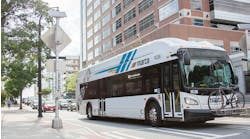This year's APTA Annual Meeting featured a number of informative sessions dealing with a multitude of issues affecting the transit industry. Here are highlights of just a few:
Public-Private Partnerships
"Opening the Door to Public-Private Partnerships" was sponsored by Parsons Corp. and discussed the advantages of private-sector partnerships. The session was moderated by Michael Schneider, chair, APTA Public-Private Partnerships Committee, and managing partner, InfraConsult LLC, Los Angeles, Calif., and focused on methods to utilize PPPs to help project sponsors manage risk, expedite project delivery, and help in the management of both capital construction and service operation.
Neil Peterson, executive advisor, CH2M HILL, Seattle, Wash., gave an update on PPPs in Toronto, Ont. According to Peterson, the province is providing $8.4 billion to retrofit both the Scarborough and Eglinton Crosstown LRT lines. Bombardier Transportation will perform this design-build project, which will be operator maintained. The service is estimated to be in place by 2020.
Stephanie Wiggins, executive officer - congestion management, Los Angeles County Metropolitan Transportation Authority (LACMTA), Los Angeles, Calif., discussed ways to deal with traffic congestion, particularly in Los Angeles. She talked about the use of high-occupancy vehicle (HOV) lanes versus high-occupancy toll (HOT) lanes in easing congestion, such as using congestion pricing to manage demand for HOT lanes, as well as using a multi-modal approach. Wiggins said that LACMTA ridership is up 50 percent since July 2011.
Richard Alexander, senior vice president, business development, Veolia Transportation, Lombard, Ill,, gave an update on Long Island bus service contracting and the use of public-private operations partnerships (PPOP). According to Alexander, the PPOP model used in Nassau resulted in reduced operations costs from $140.64 to $107.13 per hour and increased farebox recovery from 31 percent to 48 percent. He said that the goal of a PPOP is to reduce cost and improve service efficiency in order to invest in growth.
P. Takis Salpeas, senior vice president, Parsons Corp., Washington, D.C., spoke about alternative project delivery (APD) in the rail industry. According to Salpeas, rail transit issues are driving new contract models such as PMAR, as well as Front-End Engineering and Design (FEED).
MAP-21
"MAP-21 — Getting to Know the New Federal Authorizing Law!" featured U.S. Senate and House staff members who developed the new public transportation and highway authorizing law, Moving Ahead for Progress in the 21st Century (MAP-21). The panel covered some of the details of the new transit authorizing law and took questions from APTA members. The session was moderated by Jeffrey A. Nelson, chair, APTA Legislative Committee; member, APTA Board of Directors; and general manger, Rock Island County Metropolitan Mass Transit District (MetroLink), Moline, Ill. The panel highlighted what they felt were positive and negative aspects of the law.
Homer Carlisle, staff member, Chairman Tim Johnson, Committee on Banking, Housing and Urban Affairs, U.S. Senate, Washington, D.C., said that the two-year bill was formula-based, which made it less competitive. Carlisle also brought up the fact that the bill provides increased funding for tribal transit.
Shannon Hines, staff member, Ranking Member Richard Shelby, Committee on Banking, Housing and Urban Affairs, U.S. Senate, Washington, D.C., spoke about pieces of the bill such as the asset management category, the New Starts program and the safety program.
Joyce Rose, staff director, Subcommittee on Railroads, Pipelines and Hazardous Materials, Committee on Transportation and Infrastructure, U.S. House of Representatives, Washington, D.C., said the House did not pass a version of the bill before conference and that that may have had a negative impact for them. According to Rose, FTA discretionary funds went from $1.1 billion to $80 million because of the bill. She also said there is hope to move a bill in 2013 for positive train control.
James. P. Kolb, staff director, Subcommittee on Highways and Transit, Committee on Transportation and Infrastructure, U.S. House of Representatives, Washington, D.C., said the Democrats had issues with transit not being paid from the trust fund, which Republicans proposed. He highlighted the $10 million put in for TOD projects, as well as the major expansion of the Transportation Infrastructure Finance and Innovation Act (TIFIA) program.
Answers given to questions from APTA members left the general impression that where funding came from and how much funding was necessary were the biggest issues in constructing the bill. No one on the panel gave a definitive answer in regards to what will be done when the bill nears expiration.
High-Speed Rail
California will become home to the nation's first true high-speed rail system (HSR) with the signing of a law by Governor Jerry Brown authorizing the first leg of construction for a line that will eventually connect Los Angeles and San Francisco. "What's Next for High-Speed Rail in the U.S.?" covered ways in which to make California the catalyst for a national program. The session was moderated by David J. Carol, market leader, high speed rail, Parsons Brinckerhoff, Charlotte, N.C., and also sponsored by Parsons Brinckerhoff.
Panelists included David L. Borger, P.E., senior vice president, National Transportation Group-Transit Facilities, STV Inc., Rancho Cucamonga, Calif.; Carrie Pourvahidi, director of transit and rail — West Region, T.Y. Lin International, Inc., San Francisco, Calif.; Olivier Picq, transport planning director — Major International Projects Division, SNCF — French National Railway, Paris, France; Kimmo Oostermeijer, director, LeighFisher, Amsterdam, Netherlands; and Kent Rowey, partner, Freshfields Bruckhaus Deringer, New York, N.Y.
According to the panel, there is $10 billion available right now for HSR projects in various states. Things the United States can learn from Europe when it comes to HSR were discussed, with panelists suggesting the need to have a clear vision and concise project, and to take into account politics and resources available when planning HSR projects. The importance of early planning and a defined approach were also covered. Picq commented that the U.S. is where France was 30 years ago in regards to HSR. The panel also stressed the need to pick projects that can start quickly so the public can see the progress and to showcase the project by demonstrating the need and functions of HSR. According to the panel, one of the biggest challenges in getting the current HSR project in California started was selling the project to voters and government officials.





